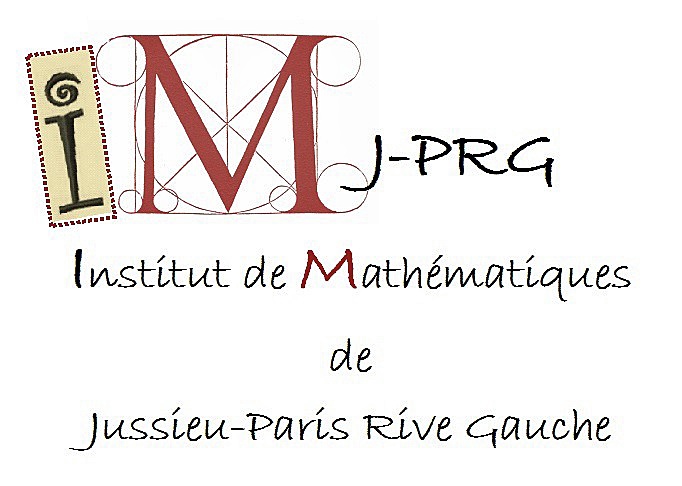Abstracts of the talks
Lotka Volterra in fluctuating environment
Michel BENAIM
Université de Neuchâtel, Neuchâtel, Suisse
We consider two dimensional Lotka-Volterra systems in a fluctuating environment. Relying on recent results on stochastic persistence and piecewise deterministic Markov processes, we show that random switching between two environments that are both favorable to the same species can lead to the extinction of this species or coexistence of the two competing species. This research was done in collaboration with Claude Lobry.
Modelling and management of waterborne diseases: using mobile phone data to study schistosomiasis
Renato CASAGRANDI
Dipartimento di Elettronica, Informazione e Bioingegneria Politecnico di Milano, Italy
Modelling the dynamics of multi-host pathogens in spatially explicit settings is not a simple task. In addition to the knowledge of traditional epidemiological parameters, one must in fact describe the movement of each of the organisms involved in the transmission cycle. Human diseases are quite critical in this respect, because it is usually hard to determine how, when and where individuals move. We present models aimed at capturing the dynamics of a parasitic disease at a country-wide scale: schistosomiasis in Senegal. Human mobility is described through the analysis of suitably anonymized mobile phone records released during the 2014 D4D Challenge by Orange-Sonatel (http://www.d4d.orange.com). A key objective of the research is showing how model-based decision-support tools can help design national plans for disease control, thus proving the importance of quantitative models for societal development.
Relationships between agriculture and biodiversity : intensive farming or agro-ecology ?
Denis COUVET
MNHN, Paris, France
The scientific, political and societal debate on biodiversity preservation has centered on the effects of two alternative methods of agricultural production: intensive farming (which leaves more land for natural spaces) and agroecology (extensive farming, which is richer in biodiversity but might occupy more land). We present original research by extending the conceptual framework developed by Green et al. (2005), who show that, for a given production target, intensive agriculture preserves more biodiversity than agroecology, because farming land induces an initially strong decrease in its biodiversity (decreasing and convex relation between biodiversity and yield). We build a theoretical model that couples the ecological assumption of Green et al. (2005) with economic assumptions on the adjustment of supply and demand to prices, in a classical economic framework where quantities supplied increase with prices while quantities demanded decrease with prices; assuming that agroecology is less profitable than intensive farming. The farming method most beneficial to biodiversity depends on the equilibrium of agricultural markets. Consumer and producer surpluses depend on the agricultural production method. We argue that a shift from intensive to agroecology primarily reduces the agricultural outlet for animal feed, characterized by a higher price elasticity, and discuss what are the implications in terms of food security.
Concurrent managing of a pigeon population spread over autonomous areas
Sylvain DUCTOR
LIP6, UPMC, Paris, France
In this talk, we consider the management of urban pigeon population when it is spread over several administrative areas. We introduce a game-theoretic formalization of this problem and propose a methodology to decompose it into a set of loosely dependent tractable local problems. We examine whether, under some reasonable assumptions, a solution of the global problem can be recomposed from solutions of the local problems thanks to interactions. The main interest of this approach is to preserve the autonomy of the local problem solvers, the mayors, by not imposing a centrally computed solution that may be undesired by some regions.
General introduction to the problem of environmental sustainability and global change
Marino GATTO
Dipartimento di Elettronica, Informazione e Bioingegneria Politecnico di Milano, Italy
The scale of human impact on our planet has been increasing decade after decade. The world population has more than doubled in less than 50 years and will probably reach 9 billion in 2040. Economic indicators of wealth have been improving, though not homogeneously over the world. However, the targets of eradicating extreme poverty and hunger, reducing child mortality, eradicating infectious diseases, achieving universal primary education, providing drinking water and sanitation facilities are far from being reached . Also, there is concern that the functioning of our earth may be imperiled by the increasing stress due to human activities. There has been an enormous increase in the emission of greenhouse gases (GHG) due to fossil fuel combustion, land-use change and agricultural practices. This has translated into a GHG concentration unprecedented in the past 800,000 years and in the global warming of our planet. Air and water pollution and overexploitation of natural resources (such as marine fish stocks) together with global climate change (GCC) may decrease the biodiversity of our planet and impair the functioning of ecosystems thus damaging the services freely provided by ecosystems to humanity. Therefore, devising paths towards the sustainability of our biosphere will be a mandatory task for humanity in the near future. Large-scale modeling t that links earth system science with demography, resource management, epidemiology and economics is necessary to achieve such an important goal.
Mathematical modelling of urban pigeon population subject to social management strategies
Ihab HAIDAR
Sorbonne Universités, Paris, France
The objective of this talk is to address the issue of managing of urban pigeon population using some possible actions that makes it reach a density target with respect to socio-ecological constraints. A mathematical model describing the dynamic of this population is introduced. This model incorporates the effect of some regulatory actions on the dynamic of this population. Viability theory provides theoretical concepts and practical tools to study the evolution of dynamical systems under state constraint. The main purpose of viability theory is to find a subset of initial states from which at least one evolution can be maintained inside the state constraint set at each time. The viability approach is used here to show how we can regulate the effectif of this population within the imposed constraints.
Local and global viability
Sophie MARTIN
UR LISC - IRSTEA, Clermont-Ferrand, France
The mathematical viability theory proposes methods and tools to study at a global level how controlled dynamical systems can be confined in a desirable subset of the state space. Multi-level viability problems are rarely studied since they induce combinatorial explosion. The question we address is in which conditions local viability concerns can enhance or ensure global viability. We propose an original approach which consists in solving first local viability problems and then studying the real viability of the combination of the local strategies, by simulation where necessary.
Collective decision-making with strategic candidates
Nicolas MAUDET
LIP6, UPMC, Paris, France
Selecting a winner or representative from a set of candidates can be done by aggregating preferences, i. e. by voting. But candidates may have some incentive to behave strategically: for instance, two candidates with close preferences may harm each other, and they may be better off if one withdraws from the election. This setting, where running or not for an election is the action space of each candidate, is known as "strategic candidacy". It gives rise to a natural game-theoretical analysis. We shall report on results investigating how different voting rules behave when facing such candidates, putting emphasis on the existence (and reachability) of equilibrium states.
Large-scale management of fisheries
Paco MELIÀ
Dipartimento di Elettronica, Informazione e Bioingegneria Politecnico di Milano, Italy
A critical aspect of fisheries management regards the inherent multidimensionality of the problems decision makers must cope with. Effective management policies must, in fact, trade-off among a multitude of different, and often conflicting, objectives whose achievement is measured along sometimes incommensurable environmental, social and economic dimensions. The protection of marine ecosystems must also take explicitly into account the different ability of organisms to move across seascapes, which ultimately results from the interaction between the physical environment and life-history, trophic and behavioural traits. We will present and discuss recent results and current research on how to cope with the multifaceted complexity of the problem and support the quest for a trade-off between biological conservation and sustainable exploitation of marine living resources.
Population viability applied to conservation sciences
Jean-Baptiste MIHOUB
UPMC and MNHN, Paris, France
Population viability is a fundamental concept in conservation sciences. Based on the understanding of key ecological mechanisms relating to genetic, demography and / or dispersal, population viability provides integrated measures on population dynamics. Besides supporting theories in ecology and evolution, population viability conveys essential guidance for biodiversity conservation practices. Since several decades, Population Viability Analysis (PVAs) frames critical aspects in the management of wildlife populations by quantifying population persistence, resilience potential or time to extinction. In addition to inform about management strategies for reversing the decline of endangered populations or for delimiting more sustainable harvest limits of exploited populations, PVAs also bring important information for conservation legislation and policy. Population viability represents for instance a decisive criteria in classification schemes designed for assessing species conservation status such as in the IUCN Red List of threatened species and in the Convention for International Trade of Endangered Species (CITES). Nevertheless, objective evaluations based on population viability remain confronted to complex aspects arising from the decision making process. Optimal strategies identified through sound scientific evidences are embedded with various degrees of uncertainty, can be inapplicable or restricted by practical constraints and is often strongly debated by stakeholders with divergent opinions. After providing a general overview of the use of population viability in conservation sciences, the presentation will provide representatives case-study examples reflecting different issues related to its application into practices. Work in collaboration with F. Sarrazin.
An overview of "bandit problems"
Vianney PERCHET
Université Denis Diderot, Paris, France
Formally, a bandit problem is the sequential and simultaneous optimization/estimation of a function in order to minimize a cumulative loss. I will describe some potential illustrating applications (ad placements, online classification, spam filtering, clinical trials, etc.) and present several variants of the original multi-armed bandit problem, the guarantees that are achievable and hints on how to obtain them.
About minimal time crisis problems and population dynamics examples.
Alain Rapaport
INRA Montpellier, France
We study an optimal control problem where the cost functional to be minimized represents the so- called time of crisis, i.e. the time spent by a trajectory solution of a control system outside a given set K. Such a problematic finds applications in several biological models and in population dynamics (e.g. chemostat model and Lotkta-Volterra systems): typically, several species compete for the same substrate, and the selection of the species of interest requires to find a control strategy that may leave and enter the crisis domain K a number of time that increases with the time interval. One important feature of the time crisis function is that it can be expressed using the characteristic function of K that is discontinuous preventing the use of the standard Maximum Principle. We provide an approximation scheme of the problem based on the Moreau-Yosida approximation of the indicator function of K and prove the the convergence of an optimal sequence for the approximated problem to an optimal solution of the original problem when the regularization parameter goes to zero. Finally, we discuss an example illustrating the convergence property and we provide sub-optimal controls based on a periodic strategy for a biological system arising in the field of bioprocesses. Work in collaboration with T. Bayen.
Partner and rival strategies for iterated games
Karl SIGMUND
University of Vienna, Wien, Austria
The iterated Prisoner's Dilemma game is the work horse of the theory of cooperation. It has recently experienced a new burst of interest, due to a class of zero-determinant strategies (introduced by Freeman Dyson and William Press) which unilaterally enforce a linear relation between the payoffs of the two players. This allows to characterize partner strategies and rival strategies. Partner strategies are designed to fairly share the social optimum. A co-player preferring an unfair solution will be penalized by a reduced payoff. A rival strategy never obtains less than the co-player. Social learning modelled by evolutionary game theory can lead from rival to partner strategies. Part of the talk will also deal with the evolution of extortion and generosity.
Composite games: strategies, equilibria, dynamics and applications.
Sylvain SORIN
IMJ-PRG, UPMC, Paris, France
Motivated by models of congestion in networks and more generally aggregative games, we consider a framework where different participants can interact: populations of non atomic players atomic players with splittable action sets atomic players with unsplittable action sets. We define and characterize the corresponding equilibria through variational inequalities. We then introduce and study the associated potential games and evolutionary dynamics.
Management of forests in a context of impulse risks
Jean-Philippe TERREAUX
IRSTEA-ADBX, Bordeaux, France
The sustainable management of forests is essential for meeting people's needs in terms of economics and social development and, more generally, for their environment. But this sustainability might be in competition with economic purposes, especially as the time scale of the resource renewal differs from that of human needs, leading to a possible exhaustion of the forests. In a deterministic framework, the complexity of the problem arises from the difference between the search for the maximum profitability of the capital invested in trees and land, over an infinite time horizon, and the search for the maximization of the values the different goods and services might provide on a stationary trajectory; not to mention the issues linked to the determination of these values. However forests, beyond the continuous tree growth, may be impacted by discrete and/or stochastic actions both of nature (gales for example) and man (the harvest of trees). In this so-called hybrid system, if possible forestry benefits are to be considered, possible losses should not be neglected. Viability theory is an attracting way to tackle this problem, and might be an interesting foundation of the forest management manuals circulating among foresters, allowing a pathway from experimental knowledge to a theoretical approach. Numerical applications concern maritime pine in Aquitaine.
On long-term repeated games
Tristan TOMALA
École des hautes études commerciales de Paris, Paris, France
This talk is about models of infinitely repeated games with perfect or imperfect observation played by rational and long-lived players. We will present results about equilibrium outcomes. We distinguish two cases: time-average vs discounted average. In the first case, we will characterize directly the equilibrium payoffs of the limit game. In the second case, we will characterize the set of equilibrium payoffs as the largest fixed point of a set valued operator and study its asymptotic behavior.
Periodic utilization of heterogeneous biological resources
Vladimir VELIOV
Institute of Statistics and Mathematical Methods in Economics Vienna University of Technology, Vienna, Austria
Models of optimal harvesting in a single-species population are known to have only asymptotically constant (steady-state) optimal solutions. On the other hand, it has been observed that the selective industrial fishing leads to detrimental effects of genetic kind (substantial reduction of the fish size). This brought into discussion the suggestion that a proper periodic fishing might be advantageous by giving the fish time to recover. In the first part of the talk, based on joint work with A. Belyakov, we show that taking into consideration the heterogeneity of fish with respect to age (not involving the genotype) may lead to proper periodic optimal harvesting in the long run. Such results are obtained for both the averaged and the discounted total revenue taken as objective function. It is proved that the selectivity of fishing plays a key role for appearance of optimal periodicity. Due to market mechanisms, periodic (oscillating) harvesting in one place generates oscillations in other places of harvesting as well. This rises a number of interesting questions about periodic special distribution of harvesting. One such question, namely about optimal space-cyclic harvesting will be the subject of the second part of the talk, based on a joint work with A. Belyakov and A. Davidov.
Imitation dynamics and dominated strategies
Yannick VIOSSAT
Université Paris-Dauphine, Paris, France
Evolutionary game dynamics model evolution of behavior in populations of weakly rational agents interacting strategically. The literature suggests that dynamics arising from imitative processes tend to wipe out irrational behaviors (strictly dominated strategies) while dynamics arising from innovative processes do not. We argue that this view is misleading and present examples of imitation dynamics under which irrational behaviors may survive.





